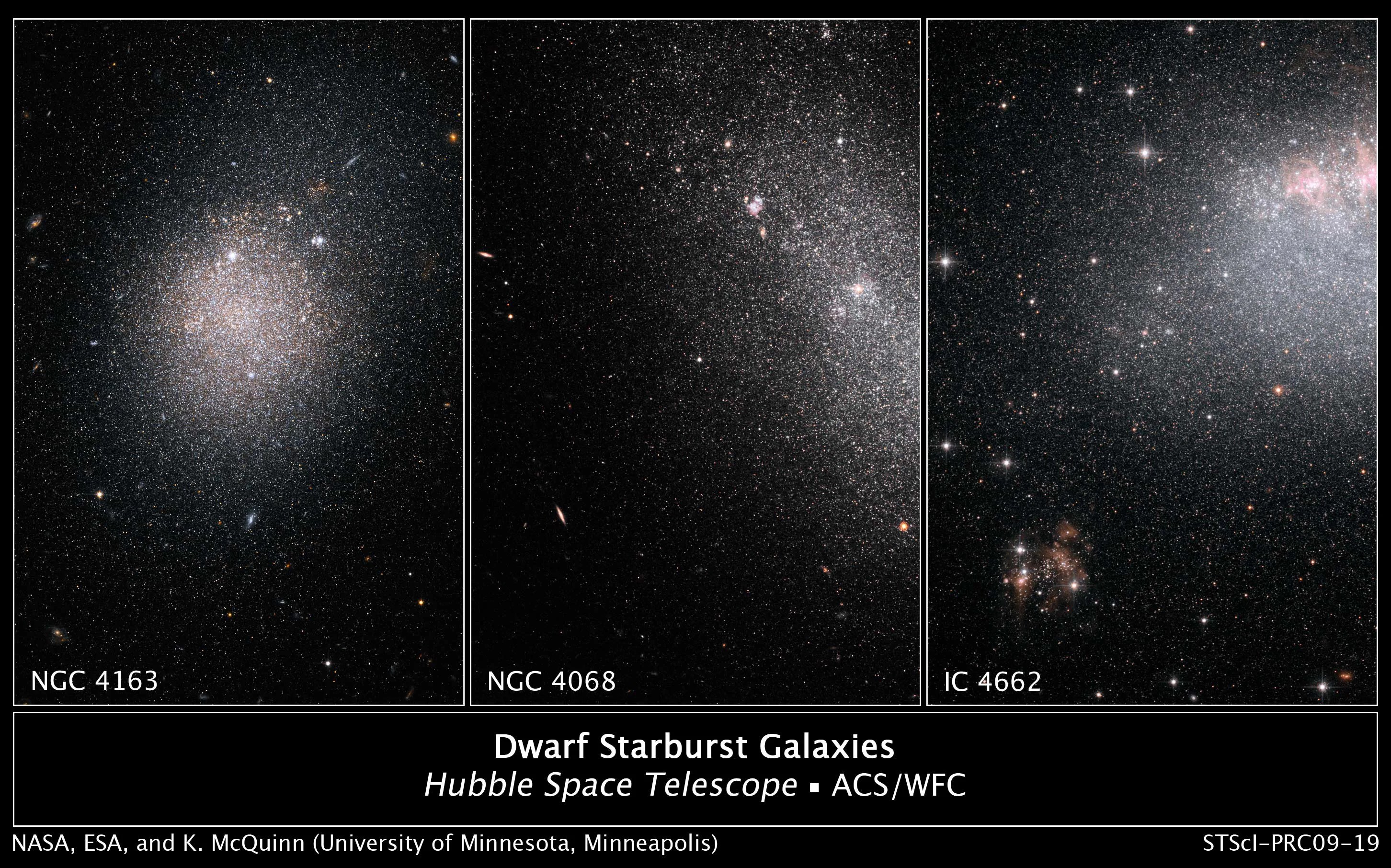4 min read

Release No. STScI-PR09-19
Credit:
NASA, ESA, and K. McQuinn (University of Minnesota, Minneapolis)
Bursts of star making in a galaxy have been compared to a Fourth of July fireworks display:They occur at a fast and furious pace, lighting up a region for a short time before winkingout.
But these fleeting starbursts are only pieces of the story, astronomers say. An analysis ofarchival images of small, or dwarf, galaxies taken by NASA's Hubble Space Telescopesuggests that starbursts, intense regions of star formation, sweep across the whole galaxyand last 100 times longer than astronomers thought. The longer duration may affect howdwarf galaxies change over time, and therefore may shed light on galaxy evolution.
"Our analysis shows that starburst activity in a dwarf galaxy happens on a global scale,"explains Kristen McQuinn of the University of Minnesota in Minneapolis and leader of thestudy. "There are pockets of intense star formation that propagate throughout the galaxy,like a string of firecrackers going off. The duration of all the starburst events in a single dwarfgalaxy would total 200 million to 400 million years."
These longer timescales are vastly more than the 5 million to 10 million years proposed byastronomers who have studied star formation in dwarf galaxies. "They were only looking atindividual clusters and not the whole galaxy, so they assumed starbursts in galaxies lastedfor a short time," McQuinn says.
Dwarf galaxies are considered by many astronomers to be the building blocks of the largegalaxies seen today, so the length of starbursts is important for understanding how galaxiesevolve.
"Astronomers are really interested to find out the steps of galaxy evolution," McQuinn says."Exploring these smaller galaxies is important because, according to popular theory, largegalaxies are created from the merger of smaller, dwarf galaxies. So understanding thesesmaller pieces is an important part of filling in that scenario."
McQuinn's team analyzed archival Advanced Camera for Surveys data of three dwarfgalaxies, NGC 4163, NGC 4068, and IC 4662. Their distances range from 8 million to 14million light-years away. The trio is part of a survey of starbursts in 18 nearby dwarf galaxies.
Hubble's superb resolution allowed McQuinn's team to pick out individual stars in thegalaxies and measure their brightness and color, two important characteristics astronomersuse to determine stellar ages. By determining the ages of the stars, the astronomers couldreconstruct the starburst history in each galaxy.
Two of the galaxies, NGC 4068 and IC 4662, show active, brilliant starburst regions in theHubble images. The most recent starburst in the third galaxy, NGC 4163, occurred 200million years ago and has faded from view.
The team looked at regions of high and low densities of stars, piecing together a picture ofthe starbursts. The galaxies were making a few stars, when something, perhaps anencounter with another galaxy, pushed them into high star-making mode. Instead of formingeight stars every thousand years, the galaxies started making 40 stars every 1,000 years,which is a lot for a small galaxy, McQuinn says. The typical dwarf is 10,000 to 30,000light-years wide. By comparison, a normal-sized galaxy such as our Milky Way is about100,000 light-years wide.
About 300 million to 400 million years ago star formation occurred in the outer areas of thegalaxies. Then it began migrating inward as explosions of massive stars triggered new starformation in adjoining regions. Starbursts are still occurring in the inner parts of NGC 4068and IC 4662.
The total duration of starburst activity depends on many factors, including the amount ofgas in a galaxy, the distribution and density of the gas, and the event that triggered thestarburst. A merger or an interaction with a large galaxy, for example, could create a longerstarburst event than an interaction with a smaller system.
McQuinn plans to expand her study to a larger sample of more than 20 galaxies. Studyingnearby dwarf galaxies, where we can see the stars in great detail, will help us interpretobservations of galaxies in the distant universe, where starbursts were much more commonbecause galaxies had more gas with which to make stars," McQuinn explains.
McQuinn's results appeared in the April 10 issue of The Astrophysical Journal.
The Hubble Space Telescope is a project of international cooperation between NASA and the European Space Agency (ESA) and is managed by NASA's Goddard Space Flight Center (GSFC) in Greenbelt, Md. The Space Telescope Science Institute (STScI) conducts Hubble science operations. The institute is operated for NASA by the Association of Universities for Research in Astronomy, Inc., Washington, D.C.
STScI is an International Year of Astronomy 2009 (IYA 2009) program partner.







